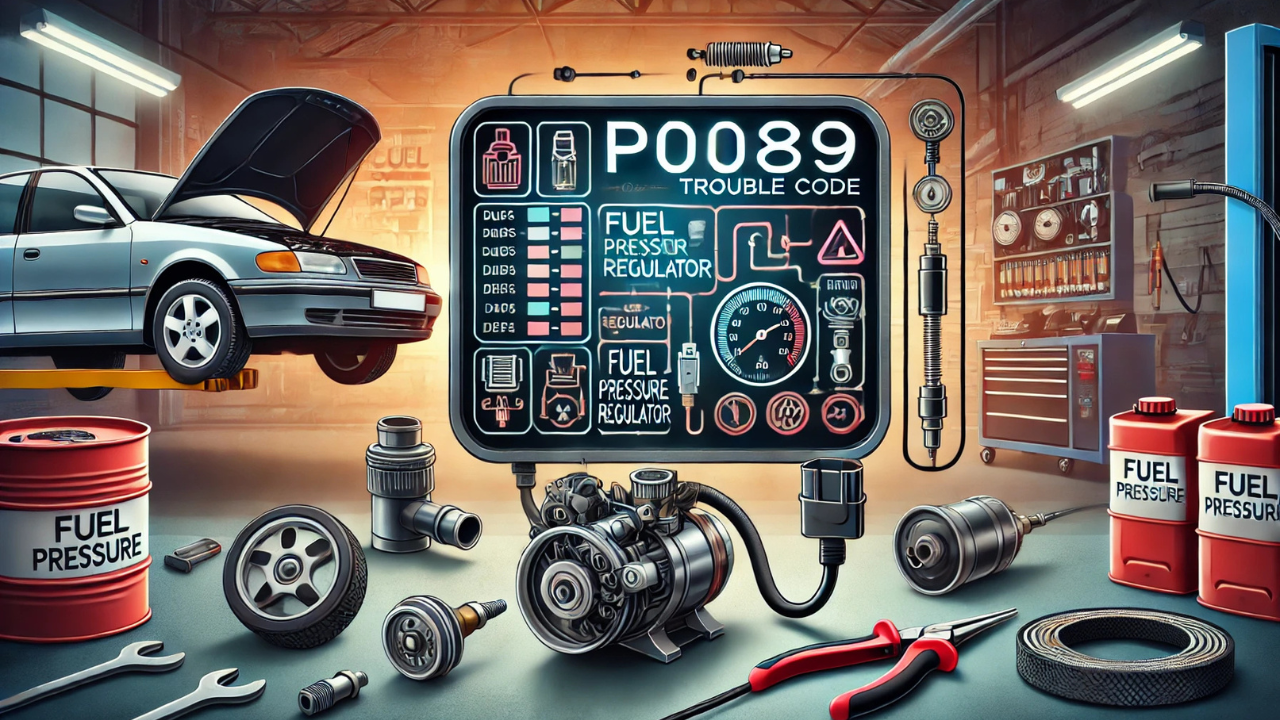The P0089 code is a diagnostic trouble code (DTC) that refers to issues in a vehicle’s fuel system, specifically a problem with the fuel pressure regulator or the fuel system’s performance. While it may sound technical, understanding what this code means, its causes, symptoms, and solutions is essential for any car owner to ensure their vehicle runs smoothly and avoid costly repairs. In this article, we will delve into the specifics of the P0089 code, how it affects your vehicle, and what steps you can take to diagnose and resolve it.
What is the P0089 Code?
The P0089 code is part of the OBD-II (On-Board Diagnostics) system, which is used by modern vehicles to monitor various functions of the engine and other essential systems. Specifically, P0089 refers to a fuel pressure regulator performance problem. The fuel pressure regulator controls the amount of fuel delivered to the engine to ensure it runs efficiently. When the vehicle’s engine control module (ECM) detects that the fuel pressure regulator is not functioning properly or fails to meet the required standards, the P0089 code is triggered.
The fuel system in a vehicle is responsible for delivering the right amount of fuel to the engine at the correct pressure. If the pressure is too high or too low, it can cause a variety of problems. The fuel pressure regulator plays a key role in maintaining the correct fuel pressure. A malfunction can disrupt the vehicle’s fuel delivery system, which can lead to poor engine performance, decreased fuel efficiency, and even engine stalling.
Causes of P0089 Code
Several factors can contribute to the activation of the P0089 code, and understanding these causes is essential in diagnosing the issue. Here are some of the common causes of the P0089 code:
Faulty Fuel Pressure Regulator: The most common reason for the P0089 code is a malfunctioning fuel pressure regulator. The fuel pressure regulator ensures that the fuel pressure remains consistent, so when it fails, it can lead to an incorrect fuel mixture being sent to the engine. A faulty regulator might cause the fuel pressure to be too high or too low, triggering the P0089 code.
Fuel Pump Issues: If the fuel pump is not functioning properly, it can create irregular fuel pressure, leading to problems with fuel delivery to the engine. In some cases, the fuel pump may need to be replaced to resolve the issue. A malfunctioning pump can also lead to low fuel pressure or an erratic fuel supply, which can result in the P0089 code.
Problems with the Fuel Pressure Sensor: The fuel pressure sensor is responsible for monitoring the pressure in the fuel system. If the sensor is defective or giving inaccurate readings, it can lead to the activation of the P0089 code. A faulty sensor may misread fuel pressure, even if the system is functioning normally, triggering a false warning.
Clogged or Leaking Fuel Lines: Over time, fuel lines can become clogged with debris, dirt, or rust, preventing the proper flow of fuel to the engine. Additionally, leaks in the fuel lines can cause a drop in fuel pressure, which can also activate the P0089 code. Fuel line issues should be addressed immediately to avoid further complications.
Electrical Malfunctions: The wiring and electrical connections related to the fuel pressure regulator, fuel pump, and sensor can also lead to P0089. Corroded or damaged wiring can prevent these components from working properly, resulting in low or irregular fuel pressure.
How is the P0089 Code Diagnosed?

Diagnosing the P0089 code requires a systematic approach to identify the root cause. A mechanic or technician will use an OBD-II scanner to retrieve the P0089 code from the vehicle’s computer. Once the code is retrieved, further steps are taken to pinpoint the exact issue. Here is a step-by-step guide on how the diagnosis typically unfolds:
Initial Inspection: The mechanic will begin by performing a visual inspection of the fuel system components, including the fuel pressure regulator, fuel pump, and fuel lines. Any visible signs of damage, wear, or leaks will be noted.
Check Fuel Pressure: Using a fuel pressure gauge, the mechanic will check the fuel pressure readings at various points in the system. If the pressure is too high or too low, it can confirm a faulty fuel pressure regulator, fuel pump, or fuel pressure sensor.
Sensor Check: The fuel pressure sensor will be checked for accuracy by comparing its readings to the actual fuel pressure readings. If there is a discrepancy, the sensor may need to be replaced.
Electrical Diagnosis: If no issues are found with the mechanical components, the mechanic will check the electrical system for faulty wiring or connections. They will use a multimeter to check the voltage and resistance across various components.
Solutions and Repairs for P0089 Code
Once the P0089 code is diagnosed, the appropriate repairs will be made depending on the root cause of the problem. Here are the potential solutions:
Replace the Fuel Pressure Regulator: If the fuel pressure regulator is determined to be faulty, it will need to be replaced. This repair is relatively straightforward and involves removing the old regulator and installing a new one that matches the vehicle’s specifications.
Fuel Pump Repair or Replacement: If the fuel pump is the culprit, it may need to be repaired or replaced. Replacing the fuel pump can be a more expensive repair, as it often requires removing the fuel tank. However, this is necessary to restore proper fuel delivery to the engine.
Replace the Fuel Pressure Sensor: A faulty fuel pressure sensor will need to be replaced to ensure that accurate readings are sent to the vehicle’s computer. This component is often easy to replace and is typically not too costly.
Repair Fuel Lines: If clogged or leaking fuel lines are detected, they will need to be cleaned, repaired, or replaced. This may involve replacing damaged sections of the fuel line or clearing any blockages.
Address Electrical Issues: If the problem lies with the electrical system, the damaged wiring or connections will need to be repaired. This may involve replacing faulty connectors or wires to restore proper functionality.
Preventative Measures to Avoid P0089 Code
Preventing the P0089 code from appearing in the future is largely about regular maintenance and paying attention to early warning signs. Here are some helpful tips:
Regular Maintenance: Ensure the fuel system is regularly maintained. This includes changing the fuel filter, checking the fuel pressure, and inspecting the fuel lines for leaks or blockages.
Quality Fuel: Using high-quality fuel can help maintain the integrity of the fuel system. Low-quality or contaminated fuel can lead to fuel system issues over time.
Replace Filters Regularly: Clogged fuel filters can disrupt fuel flow and lead to issues with fuel pressure. Replace the fuel filter at the intervals recommended by the vehicle’s manufacturer.
Check Electrical Systems: Regularly inspect the vehicle’s electrical system to ensure that there are no issues with wiring or connections. This can help prevent problems with the fuel system components.
Conclusion
The P0089 code is an important issue to address if it appears in your vehicle. Ignoring this problem can lead to poor engine performance, decreased fuel efficiency, and potentially costly damage. By understanding the causes, symptoms, and diagnostic process for the P0089 code, you can take the necessary steps to prevent and repair the issue. Regular maintenance of the fuel system, proper use of quality fuel, and timely repairs can help keep your vehicle running smoothly and avoid future complications.
FAQs
What does the P0089 code mean in a vehicle?
The P0089 code indicates a problem with the fuel pressure regulator, which can lead to improper fuel pressure affecting engine performance.
Can I drive my car with the P0089 code?
While it may be safe for short distances, driving with the P0089 code can cause poor engine performance and reduced fuel efficiency. It’s best to get it diagnosed and repaired as soon as possible.
How much does it cost to fix the P0089 code?
The cost can vary depending on the cause of the issue. Replacing the fuel pressure regulator or fuel pump can range from $200 to $1,000, depending on the severity of the problem.
Is the P0089 code serious?
Yes, the P0089 code should be taken seriously. It affects the fuel delivery system, which is critical for the vehicle’s performance and fuel efficiency.
How do I know if my fuel pump is causing the P0089 code?
If your vehicle is having trouble starting, stalling, or experiencing rough idling, the fuel pump could be at fault.
Can a dirty fuel filter trigger the P0089 code?
Yes, a clogged fuel filter can affect fuel pressure and trigger the P0089 code.
Is the P0089 code related to engine performance issues?
Yes, improper fuel pressure can cause a range of engine performance problems, including misfires, rough idling, and stalling.
How long does it take to fix the P0089 code?
Depending on the repair required, fixing the P0089 code can take anywhere from a few hours to a full day of work.
You May Also Read: https://ventsbuzz.pro/volvo-vin-decoder/




